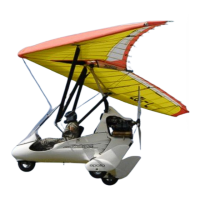6.7.9 Landing
Landing should always be into wind with a long straight approach. A descending
approach to the airstrip can be made with or without power, but in either case the
airspeed should be maintained above the nominated approach speed. The ultralight
should be flown on final approach at or above the nominated safety speed (see:
5.4.1) with the control bar in. The additional airspeed allows for wind gradient, and
provide greater controllability in the rough air that may be experienced when
approaching the ground. Maintaining airspeed on final is very important for engine-
off landings, allowing a margin for round out before touch down.
When at about 3 meter break the glide angle and by allowing control bar to go ahead
round the flight path to the ground at about a height of 30 cm. Keep this height („flare
out”) until the speed decreases below the minimum, a stall occurs and the main
wheels touch the ground.
The trike is designed to land with the rear wheels touching down slightly before the
nose wheel. Keep the nose wheel in the air as long as you can then allow it to touch
the ground also. Once firmly on the ground aerodynamic braking may be achieved
by pulling in the control bar, then operating the front nose wheel brake.
NOTE
Do not forget: maximum rolling speed on a paved runway is 30 km/h, on grass or on
dirt road it is 20 km/h.
.
6.7.10 Cross Wind Landing and Take Off
Pilots with less experience should avoid landing or taking off in conditions with high
crosswind components, as skills do not always match the capabilities of the
ultralight. Crosswind landings or take off with low wind components up to 3 m/s are
quite safe and controllable, even to the inexperienced pilot. At greater crosswind
components the officially accepted instructor experience is to be followed.
NOTE
After a hard landing, your ultralight must be completely checked.
Capabilities to handle crosswind take offs and landings are to be obtained from
instructors.
6.7.11 Stopping the motor
Roll to the parking place. The ignitions should be switched off at idle. Switching off at
high RPM floods the engine and makes restarting difficult. If the engine has been
running under full power allow the engine to cool at idle, before switching off. Set the
ignition switches to OFF, log the flight time into the aircraft logbook and switch off the
master switch, also.

